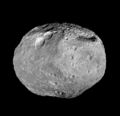Difference between revisions of "File:Vesta.jpg"
(uploaded a new version of "File:Vesta.jpg": Replaced earlier image with even crisper composite image - source http://apod.nasa.gov/apod/ap120919.html) |
m |
||
| (2 intermediate revisions by the same user not shown) | |||
| Line 1: | Line 1: | ||
| − | + | Last week the robotic Dawn spacecraft ended its year-long mission to asteroid [[4 Vesta|Vesta]], becoming the first spacecraft ever to visit this far off world located between [[Mars]] and [[Jupiter]], in the Solar System's [[The Main Belt|main asteroid belt]]. Many of the best images taken by Dawn at Vesta have been compiled into the above encompassing view. Vesta shows evidence of being a leftover from the early years of our Solar System, a building block for rocky planets like [[Earth]]. Vesta's ancient surface shows heavy cratering and long troughs likely created by huge impacts. The minor planet's low gravity allows for surface features like huge cliffs and a large mountain that reaches twice the height of Earth's Mount Everest, visible at the image bottom. Vesta, however, spanning about 500 kilometers across, is only the ''second'' most massive object in the asteroid belt. And so, two weeks ago, Dawn fired its gentle ion rockets and has begun chasing the most massive: [[1 Ceres|Ceres]]. | |
| − | Image credit: NASA | + | Image credit: NASA, JPL-Caltech, UCLA, MPS, DLR, IDA<br /> |
| + | Image source: http://apod.nasa.gov/apod/ap120919.html | ||
[[Category:Main Belt]] | [[Category:Main Belt]] | ||
Latest revision as of 13:01, 19 September 2012
Last week the robotic Dawn spacecraft ended its year-long mission to asteroid Vesta, becoming the first spacecraft ever to visit this far off world located between Mars and Jupiter, in the Solar System's main asteroid belt. Many of the best images taken by Dawn at Vesta have been compiled into the above encompassing view. Vesta shows evidence of being a leftover from the early years of our Solar System, a building block for rocky planets like Earth. Vesta's ancient surface shows heavy cratering and long troughs likely created by huge impacts. The minor planet's low gravity allows for surface features like huge cliffs and a large mountain that reaches twice the height of Earth's Mount Everest, visible at the image bottom. Vesta, however, spanning about 500 kilometers across, is only the second most massive object in the asteroid belt. And so, two weeks ago, Dawn fired its gentle ion rockets and has begun chasing the most massive: Ceres.
Image credit: NASA, JPL-Caltech, UCLA, MPS, DLR, IDA
Image source: http://apod.nasa.gov/apod/ap120919.html
File history
Click on a date/time to view the file as it appeared at that time.
| Date/Time | Thumbnail | Dimensions | User | Comment | |
|---|---|---|---|---|---|
| current | 12:56, 19 September 2012 |  | 715 × 694 (43 KB) | Robkelk (Talk | contribs) | Replaced earlier image with even crisper composite image - source http://apod.nasa.gov/apod/ap120919.html |
| 06:07, 16 July 2011 |  | 800 × 600 (18 KB) | Mal-3 (Talk | contribs) | Replaced blurry Hubble image with nice, crisp image from Dawn. | |
| 19:59, 21 February 2010 |  | 180 × 180 (5 KB) | Robkelk (Talk | contribs) | removed text from lower third of image, cropped some of the black space around the image | |
| 17:08, 24 January 2010 |  | 267 × 325 (9 KB) | Robkelk (Talk | contribs) | Hubble Space Telescope image Category:Places in Fenspace Category:Main Belt |
- You cannot overwrite this file.
File usage
The following 3 pages link to this file: